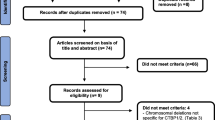Abstract.
Recently, a member of the GATA-binding family of transcription factors was shown to be involved in the human hypoparathyroidism, sensorineural deafness and renal anomalies (HDR) syndrome. Deletion-mapping studies and subsequent mutation analysis revealed that haploinsufficiency for GATA3 is the underlying mechanism of the HDR syndrome. Here we discuss the clinical characteristics of the HDR syndrome and present an overview of the role of GATA3 and related GATA-binding transcription factors during vertebrate embryonic development and their involvement in human disease.
Similar content being viewed by others
Author information
Authors and Affiliations
Additional information
Received 12 February 2001; received after revision 28 March 2001; accepted 28 March 2001
Rights and permissions
About this article
Cite this article
Van Esch, H., Devriendt, K. Human Genome and Diseases: Review¶Transcription factor GATA3 and the human HDR syndrome. CMLS, Cell. Mol. Life Sci. 58, 1296–1300 (2001). https://doi.org/10.1007/PL00000940
Issue Date:
DOI: https://doi.org/10.1007/PL00000940




